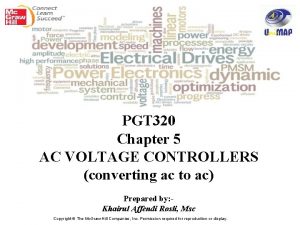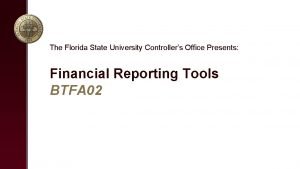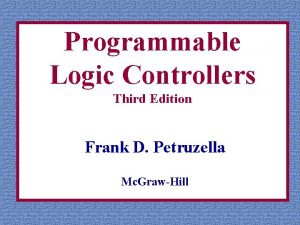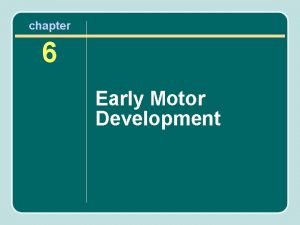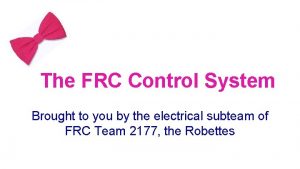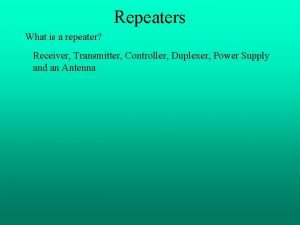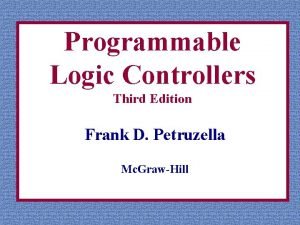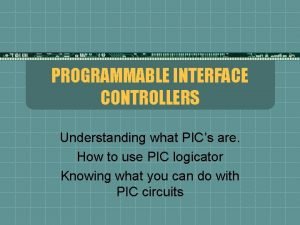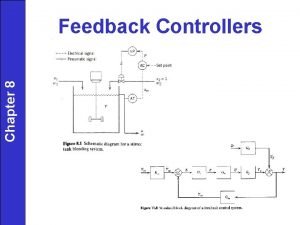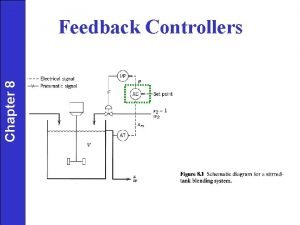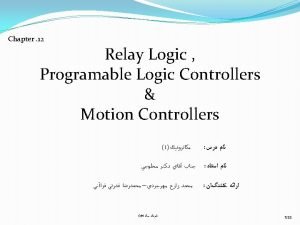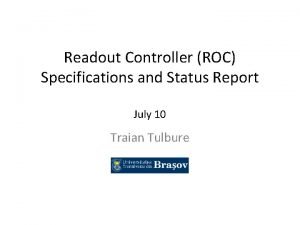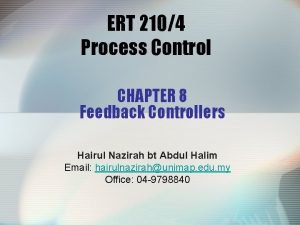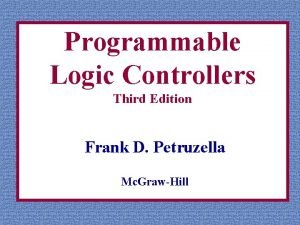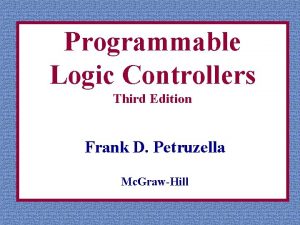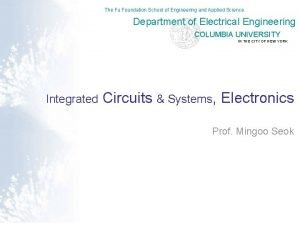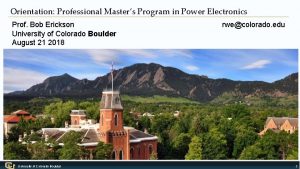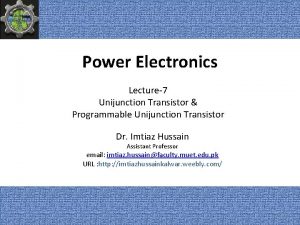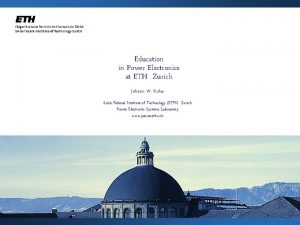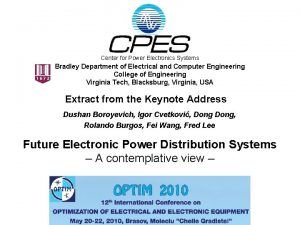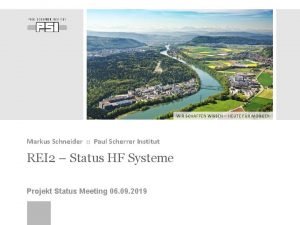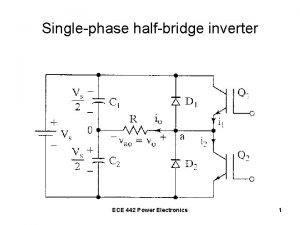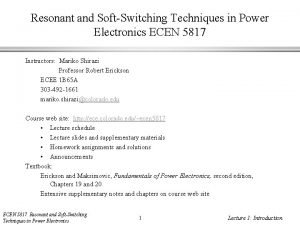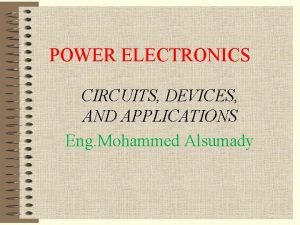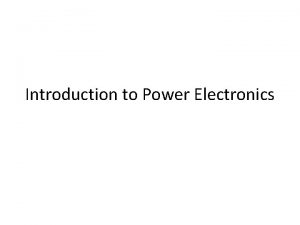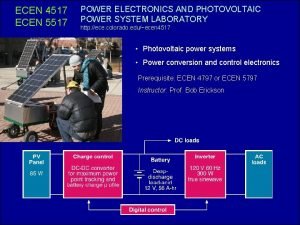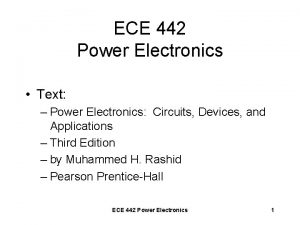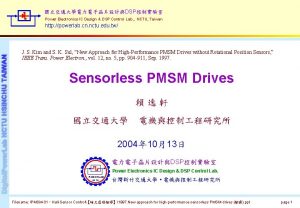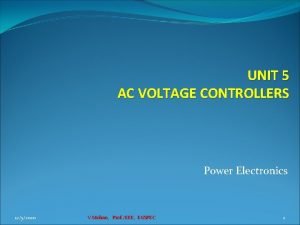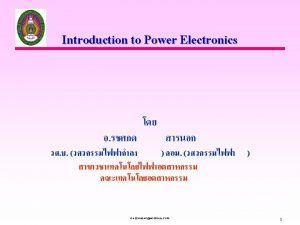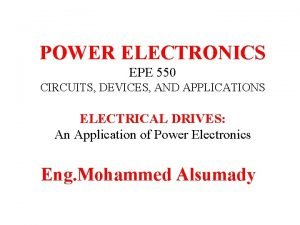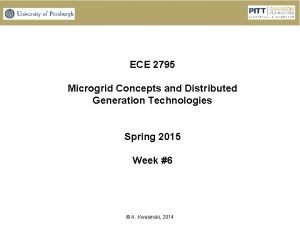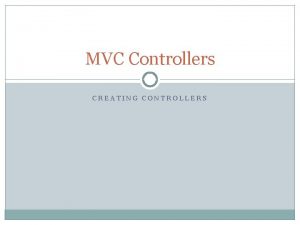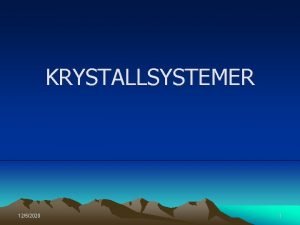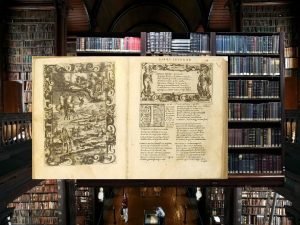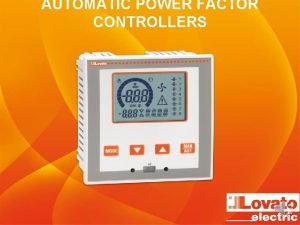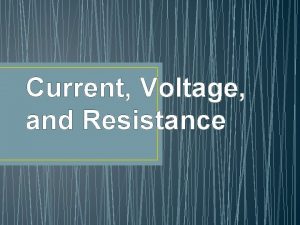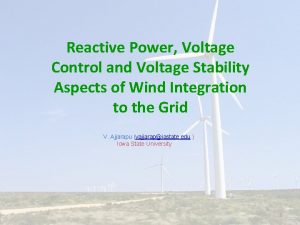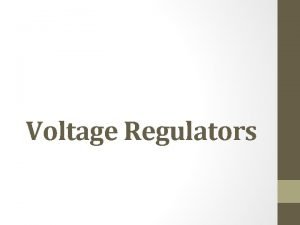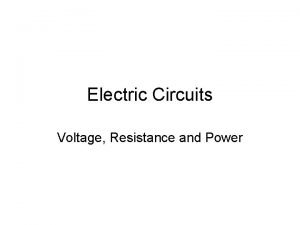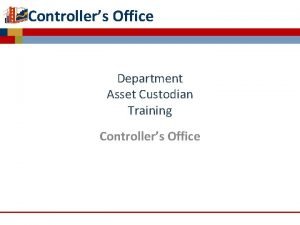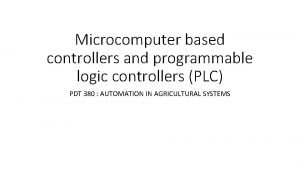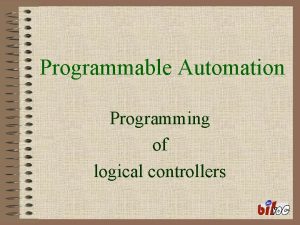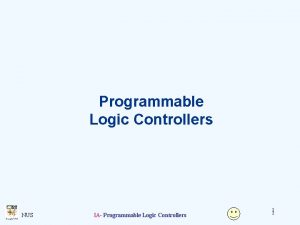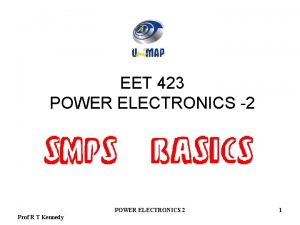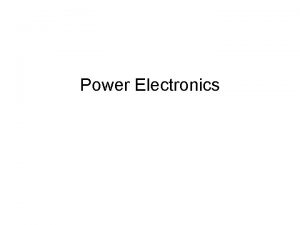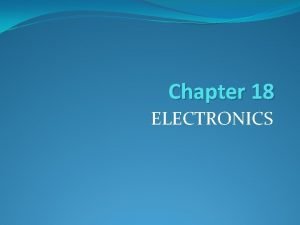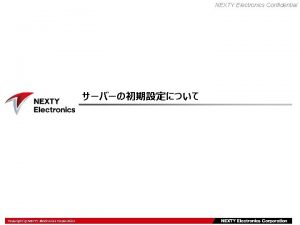UNIT 5 AC VOLTAGE CONTROLLERS Power Electronics 1252020









































- Slides: 41

UNIT 5 AC VOLTAGE CONTROLLERS Power Electronics 12/5/2020 V. Mohan, Prof. /EEE, EGSPEC 1

INTRODUCTION The power flow into a load can be controlled by varying the rms value of the load voltage. This can be accomplished by thyristors, and this type of power circuit is known as ac voltage controllers. 12/5/2020 V. Mohan, Prof. /EEE, EGSPEC 2

TYPE OF AC VOLTAGE CONTROLLERS Classification based on the type of input ac supply: Single Phase AC Controllers Three Phase AC Controllers Each type of controller may be sub divided into: Unidirectional or half wave ac controller Bi-directional or full wave ac controller In brief different types of ac voltage controllers are: Single phase half wave ac voltage controller (uni-directional controller) Single phase full wave ac voltage controller (bi-directional controller) Three phase half wave ac voltage controller (uni-directional controller) Three phase full wave ac voltage controller (bi-directional controller) 12/5/2020 V. Mohan, Prof. /EEE, EGSPEC 3

APPLICATIONS OF AC VOLTAGE CONTROLLERS Lighting / Illumination control in ac power circuits. Induction heating. Industrial heating & Domestic heating. Transformers tap changing (on load transformer tap changing). Speed control of induction motors (single phase and poly phase ac induction motor control). AC magnet controls. 12/5/2020 V. Mohan, Prof. /EEE, EGSPEC 4

AC VOLTAGE CONTROL TECHNIQUES two types of control are normally used: On-off Control Phase angle control In on-off control, thyristor switches connect the load to the ac source for a few cycles of the input voltage and then disconnected for a few cycles. In phase control, thyristor switches connect the load to the ac source for a portion of each cycle. 12/5/2020 V. Mohan, Prof. /EEE, EGSPEC 5

COMMUTATION Since the input voltage is ac, thyristors are line commutated. Typically phase control thyristors which are cheaper are used. For applications up to 400 Hz, TRIACs are used. 12/5/2020 V. Mohan, Prof. /EEE, EGSPEC 6

PRINCIPLE OF ON-OFF CONTROL (INTEGRAL CYCLE CONTROL) 12/5/2020 V. Mohan, Prof. /EEE, EGSPEC 7

This type of control is applied in applications which have high mechanical inertia and high thermal time constant. Typical examples are industrial heating and speed control of motors. 12/5/2020 V. Mohan, Prof. /EEE, EGSPEC 8

If the input voltage is connected to load for n cycles and is disconnected for m cycles, the output load voltage is found from: Note that called isk the duty cycle, and the power factor and output voltage vary with the square root of k. 12/5/2020 V. Mohan, Prof. /EEE, EGSPEC 9

PRINCIPLE OF PHASE CONTROL The principle of phase control can be explained with the following circuit. 12/5/2020 V. Mohan, Prof. /EEE, EGSPEC 10

Due to the presence of diode D 1, the control range is limited. The rms output voltage can only be varied between 70. 7 to 100%. The output voltage and input current asymmetrical and contain a dc component. 12/5/2020 V. Mohan, Prof. /EEE, EGSPEC are 11

This circuit is a single-phase half-wave controller and is suitable only for low power resistive loads, such as heating and lighting. Since the power flow is controlled during the positive half-cycle of input voltage, this type of controller is also known as unidirectional controller. 12/5/2020 V. Mohan, Prof. /EEE, EGSPEC 12

The rms value of the output voltage is : The average value of the output voltage is: 12/5/2020 V. Mohan, Prof. /EEE, EGSPEC 13

SINGLE-PHASE BIDIRECTIONAL CONTROLLERS WITH RESISTIVE LOADS The problem of dc input current can be prevented by using bidirectional or full-wave control. 12/5/2020 V. Mohan, Prof. /EEE, EGSPEC 14

The firing pulse of T 1 and T 2 are 180 degrees apart. The rms value of the output voltage is: By varying α from 0 to π, Vo can be varied from Vs to 0. 12/5/2020 V. Mohan, Prof. /EEE, EGSPEC 15

SINGLE-PHASE CONTROLLERS WITH INDUCTIVE LOAD In practice, most loads are inductive to a certain extent. 12/5/2020 V. Mohan, Prof. /EEE, EGSPEC 16

The gating signals of thyristors could be short pulses for a controller with a resistive load. However, they are not suitable for inductive loads. When thyristor T 2 is fired, thyristor T 1 is still conducting due to the inductive load. By the time the current of T 1 falls to zero and T 1 is turned off, the gate current of T 2 has already ceased. Consequently, T 2 will not be turned on. This difficulty can be resolved by using a continuous gate signal with a duration of π - α. 12/5/2020 V. Mohan, Prof. /EEE, EGSPEC 17

However a continuous gate pulse increases the switching loss of thyristors. In practice a train of pulses with short duration are used to overcome the loss problem. The rms value of the output load voltage is found from: 12/5/2020 18 V. Mohan, Prof. /EEE, EGSPEC

THREE-PHASE FULL-WAVE CONTROLLERS The unidirectional controllers, which contain dc input current and higher harmonic content due to the asymmetrical nature of the output voltage waveform, are not normally used in ac motor drives. A three-phase bidirectional control is commonly used. 12/5/2020 V. Mohan, Prof. /EEE, EGSPEC 19

30 o 12/5/2020 V. Mohan, Prof. /EEE, EGSPEC 20

For 0 < α < 60 o: For 60 o < α < 90 o: For 90 o < α < 150 o: 12/5/2020 V. Mohan, Prof. /EEE, EGSPEC 21

THREE-PHASE BIDIRECTIONAL DELTA-CONNECTED CONTROLLERS If the terminals of a three-phase system are accessible, the control elements (SCRs) and load may be connected in delta. 12/5/2020 V. Mohan, Prof. /EEE, EGSPEC 22

Since the phase current in a normal three-phase delta system is only 1/√ 3 of the line current, the current ratings of the thyristors are less. The following figure shows the waveforms for a delay angle of 120 degrees. 12/5/2020 V. Mohan, Prof. /EEE, EGSPEC 23

60 o 12/5/2020 V. Mohan, Prof. /EEE, EGSPEC 24

For resistive loads: 12/5/2020 V. Mohan, Prof. /EEE, EGSPEC 25

CYCLOCONVERTERS The ac voltage controllers provide a variable output voltage, but the frequency of the output voltage is fixed. In addition the harmonic content is high at low ac voltages (high α). A variable output voltage at variable frequency can be obtained from a two stage conversion. 12/5/2020 V. Mohan, Prof. /EEE, EGSPEC 26

First the fixed ac is converted to a variable dc (controlled rectifier), and then the variable dc is converted to a variable ac at variable frequency (inverter). However, the cycloconverter can eliminate the need of one or more intermediate converters. A cycloconverter is a direct frequency changer that converts ac power at one frequency to ac power at another frequency by ac-ac conversion. 12/5/2020 V. Mohan, Prof. /EEE, EGSPEC 27

Cycloconverters are naturally commutated and the maximum output frequency is a fraction of the source frequency. Therefore, cycloconverters are low speed ac motor drives in ranges up to 15 MW with frequencies from 0 to 20 Hz. 12/5/2020 V. Mohan, Prof. /EEE, EGSPEC 28

SINGLE-PHASE CYCLOCONVERTERS The principle of operation of single-phase cycloconverters can be explained with the following figure. First, two single-phase controlled operated as bridge rectifiers. converters are Their delay angles are such that the output voltage of one converter is equal and opposite to that of the other converter. If αp is the delay angle of positive converter, the delay angle of the negative converter is: αn = π – αp 12/5/2020 V. Mohan, Prof. /EEE, EGSPEC 29

12/5/2020 V. Mohan, Prof. /EEE, EGSPEC 30

THREE-PHASE CYCLOCONVERTER The circuit diagram of a three-phase/single phase cycloconverter is shown next. The synthesis of output waveform for an output frequency of 12 Hz is also in this figure. 12/5/2020 V. Mohan, Prof. /EEE, EGSPEC 31

12/5/2020 V. Mohan, Prof. /EEE, EGSPEC 32

The cycloconverter of previous figure can be extended to feed a three-phase load, by having six three-phase converters. If six full-wave three-phase converters are used, 36 thyristors would be required. 12/5/2020 V. Mohan, Prof. /EEE, EGSPEC 33

12/5/2020 V. Mohan, Prof. /EEE, EGSPEC 34

REDUCTION OF OUTPUT HARMONICS The output voltage of cycloconverters is basically made up of segments of input voltages. The average value of a segment depends on the delay angle for that segment. If the delay angles of segments were varied in such a way that the average values of segments corresponds as closely as possible to the variations of desired sinusoidal output voltage, the harmonics on the output voltage can be minimized. 12/5/2020 V. Mohan, Prof. /EEE, EGSPEC 35

The delay angles for segments can be generated by comparing a cosine signal at the source frequency with an ideal sinusoidal reference voltage at the output frequency. The following figure shows generation of the gating signals for the cycloconverter. 12/5/2020 V. Mohan, Prof. /EEE, EGSPEC 36

12/5/2020 V. Mohan, Prof. /EEE, EGSPEC 37

12/5/2020 V. Mohan, Prof. /EEE, EGSPEC 38

12/5/2020 V. Mohan, Prof. /EEE, EGSPEC 39

12/5/2020 V. Mohan, Prof. /EEE, EGSPEC 40

12/5/2020 V. Mohan, Prof. /EEE, EGSPEC 41
 On-off control is also called as
On-off control is also called as Applications of ac voltage controller
Applications of ac voltage controller What is considered high voltage
What is considered high voltage Power formula three phase
Power formula three phase Peak value of current formula
Peak value of current formula Step voltage and touch voltage
Step voltage and touch voltage Power trianlge
Power trianlge Fsu controllers office
Fsu controllers office Programmable logic controllers frank d petruzella
Programmable logic controllers frank d petruzella Rate limiters for infants
Rate limiters for infants Frc motor controllers
Frc motor controllers Riverbed magic quadrant
Riverbed magic quadrant Vacillator attachment style
Vacillator attachment style Controllers & repeaters
Controllers & repeaters Frank d petruzella programmable logic controllers
Frank d petruzella programmable logic controllers Programmable pic
Programmable pic Ncp1568
Ncp1568 The controllers chapter 8
The controllers chapter 8 Example of reverse acting controller
Example of reverse acting controller Relay logic controllers
Relay logic controllers Plunger lift troubleshooting
Plunger lift troubleshooting Roc-2015 ro controllers supplier
Roc-2015 ro controllers supplier The controllers chapter 8
The controllers chapter 8 Programmable logic controllers frank d petruzella
Programmable logic controllers frank d petruzella Programmable logic controllers frank d petruzella
Programmable logic controllers frank d petruzella Fu foundation school of engineering
Fu foundation school of engineering Ecen 5797
Ecen 5797 Programmable ujt
Programmable ujt Eth power electronics
Eth power electronics Center for power electronics systems
Center for power electronics systems Ampegon power electronics ag
Ampegon power electronics ag Electronics q
Electronics q Switch network
Switch network Power electronics circuits devices and applications
Power electronics circuits devices and applications Introduction to power electronics
Introduction to power electronics Power electronics
Power electronics Power electronics
Power electronics Dsp in power electronics
Dsp in power electronics Ac voltage controller and cycloconverter
Ac voltage controller and cycloconverter Power electronics
Power electronics Power electronics
Power electronics Rectifier power electronics
Rectifier power electronics

